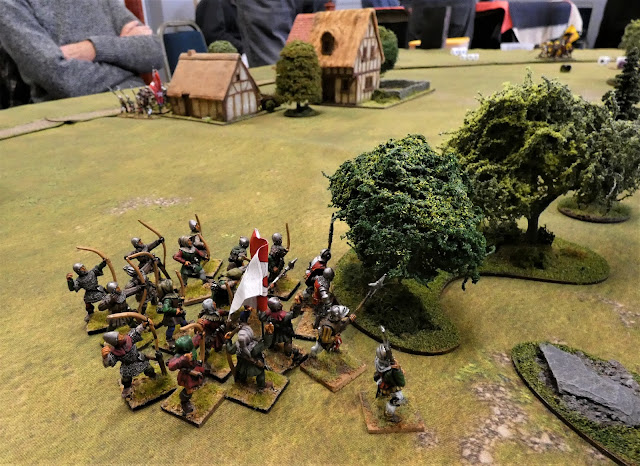This month, I and a few of the chaps got together to playtest a set of rules being developed by Dr Rob Jones for playing medieval skirmishes in the Hundred Years War, called Écorchers.
I've featured Rob's presentations at Crusade Wargames Show on JJ's Wargames together with his rule adaptation for A Coat of Steel, links below
 |
| http://jjwargames.blogspot.com/2021/06/blood-horse-droppings-wotr-rules-from.html |
 |
| The two English retinues of twenty figures each with a commander and banner and with the Lord accompanied by a musician |
So in a combined effort to pull together terrain, figures and playing materials, we laid out the table seen above and below, all set to play the Meeting Engagement scenario, with a typical French hamlet, together with pigs in the pigsty ready to receive our roving forces from the French and English armies in the area, keen on securing provisions at the expense of the locals.
The combat system relies on a set of opposed combat dice being rolled to assess the outcome, that can be replaced with ordinary d6 should you prefer, but we played with half a dozen prepared dice, with each face displaying from left to right, the shield, to counter the strike and stun, the sword, usually a killing result; the cross swords a feint, giving the wild option of a reroll or strike, stun or shield to be played and called out prior to rolling; the compass or Fortune's Wheel, gaining a coin for the purse and used to pay for actions taken or die roll modifying; a soldier, indicating a shove back in melee, and a mace indicating a stunning blow, leaving the opponent stunned and only able to defend himself and, until rallied, liable to death should a second stun be inflicted to the first.
The first initiative and attempts to grab it from opposing commanders was resolved with each player rolling their respective command die, a d8, d10 or d12, which could be moderated by the spending of coins from the Lord's purse, adding one to the score for each, but requiring a commander to score at least 4 or higher and to beat the opposing commanders score, with a 1 always failing.
The activation limits are controlled by the number of coins in a Lord's purse at any given time (for coins, we used a pile of old penny pieces), needing to spend a coin to activate, by passing it to the opposing player and with each commander getting half the combat die type in coins at the start of play.
Plus any failed activation attempt automatically passed the initiative to the opponents.
Of course both sides had to also keep the other at bay whilst doing so.
Both sides attempted to close on the hamlet with a force early on and seeing the French detach their hobilars to deal with a similarly detached group of English archers and sergeants, taking shelter by a nearby wood ready to provide overwatch archery to their comrades in the village.
As wargamers are want to do, both sides were keen to see how the combat process worked and the hobilars managed to close on their opponents, but not sufficiently fast enough to turn their contact into a full blown charge, as the wood took its inevitable effect on their movement rate.
Both sides set at it with spear and sword as men were killed outright, driven back and
/or stunned, with the advantage swinging to the English in the early exchanges as their numbers made up for the additional combat dice rolled by their opponents for being mounted.
The rules allow for opposing lord's to call for quarter, which if the opposing commander is within four inches, it is expected to be honoured, with the captured leader escorted to the rear by a detailed man, leaving nearby survivors of the affected retinue to take a stun test.
Meanwhile in the village the French mounted knights were getting an equally hard time facing the other English retinue that, having come off lightly in the first contact, with both sides suffering push backs and stuns, proceeded to shoot the French out of their saddles at close range, preventing the follow up men from closing and making full use of their heavy swords, armour and big horses.
With their mounted comrades getting a seeing too from the English, and having only managed to loose off a couple of desultory rounds of crossbow shots, the French foot wisely decided to withdraw.
Thank you to Colin, David, Ian, Bob and Tom for applying their undoubted gaming experience to what was a totally new set of rules for all of us and I'm sure we made some mistakes on our interpretation of them, but that will come out in the feedback for Rob.
Thanks chaps
JJ



















Thanks for trying out the rules, and for your feedback. I hope that evryone had a good time wiht the rules.
ReplyDeleteAn interesting game an nice medieval eye candy.
ReplyDeleteWillz.